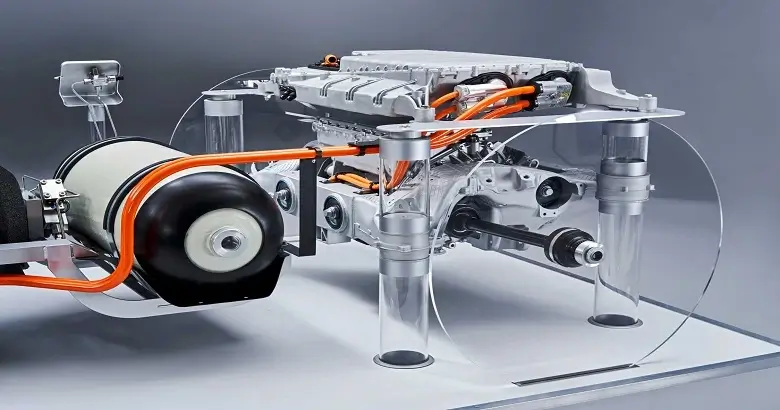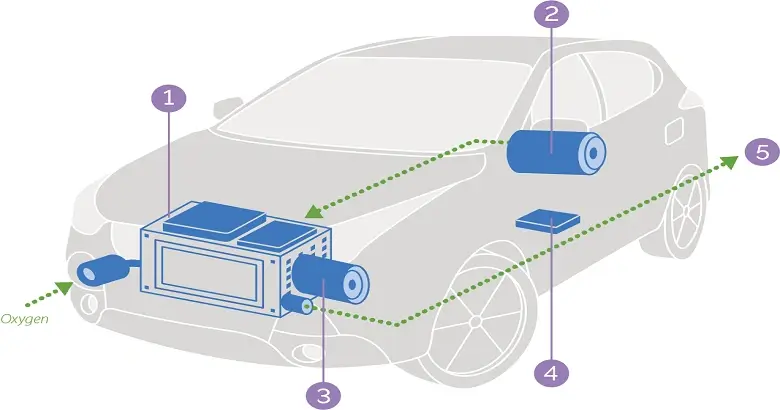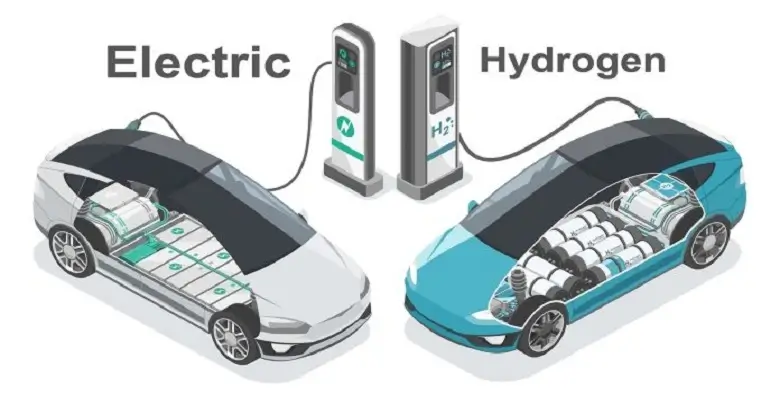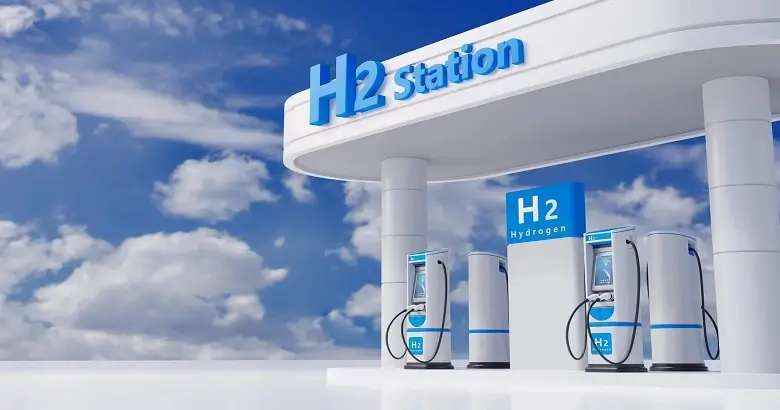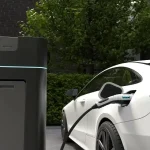Fuel cell vehicles (FCVs) and battery electric vehicles (BEVs) both run on electricity, but the way they produce, store, and deliver that energy couldn’t be more different. If you’ve ever wondered why automakers are investing in both hydrogen and battery-powered technologies, the answer lies in the unique strengths each platform offers.
What Is a Fuel Cell and How Does It Generate Electricity?
The core technology that powers a fuel cell vehicle is called a Proton Exchange Membrane (PEM) fuel cell, a compact electrochemical engine that creates electricity from hydrogen and oxygen. When you refuel a hydrogen car, like the Toyota Mirai or Honda Clarity Fuel Cell, compressed hydrogen is stored in onboard high-pressure tanks. When the car is turned on, the hydrogen gas flows into the fuel cell where it undergoes a chemical reaction:
- Step 1: Hydrogen molecules are split into protons and electrons.
- Step 2: Electrons travel through an external electric circuit (this generates the electricity that powers the electric motor).
- Step 3: Protons pass through the PEM membrane.
- Step 4: On the other side, protons and electrons recombine with oxygen from the air to form water vapor, emitted from the tailpipe as the only byproduct.
This process enables on-demand electricity generation, which is what truly sets fuel cell cars apart from battery EVs. Instead of storing electricity in advance like a BEV, an FCV produces electricity as you drive, as long as it has a supply of hydrogen.
Storage Showdown: Batteries vs. Hydrogen Tanks
One of the most defining differences between fuel cell cars and battery EVs lies in how energy is stored and accessed.
- Battery Electric Vehicles (BEVs): Vehicles like Tesla’s Model Y or Model 3 store energy in large lithium-ion batteries. These batteries must be recharged from external power sources, like home chargers or public fast-charging stations. Their efficiency is high, but charging can take time and requires significant infrastructure.
- Fuel Cell Vehicles (FCVs): In contrast, vehicles like the Honda Clarity Fuel Cell or the Nikola Tre FCEV store compressed hydrogen gas in lightweight carbon-fiber tanks. This hydrogen feeds into the PEM fuel cell, producing electricity in real time.
Because FCVs don’t carry the burden of massive batteries, they tend to be lighter, especially important in long-distance and heavy-duty applications like trucking.
Refueling vs. Recharging
A major selling point for hydrogen vehicles is their refueling speed. A hydrogen car can be refueled in just 3 to 5 minutes, comparable to filling up a gasoline tank. BEVs, however, require significantly more time:
- Fast-charging: 30 minutes or more for an 80% charge.
- Level 2 charging: 4–10 hours, typically at home or public stations.
This time disparity is particularly important for commercial applications. Fleets can’t afford to wait hours between uses. That’s why companies like Ballard Power Systems, a global leader in fuel cell technology, are investing heavily in FCVs for logistics, transit, and industrial sectors where uptime matters most.
Weight, Range, and Cold Weather Performance
Let’s break down how FCVs and BEVs compare on other key performance metrics:
- Weight: Lithium-ion batteries are heavy. Fuel cell systems with hydrogen tanks are generally lighter, making FCVs more suitable for larger vehicles like buses and trucks. For instance, the BMW iX5 Hydrogen SUV combines fuel cell efficiency with long-range capabilities while maintaining a lighter overall profile than a comparable BEV.
- Range: FCVs offer comparable or greater range than many BEVs. The Toyota Mirai, for example, provides over 400 miles per tank, a competitive number in today’s EV market.
- Cold Weather: BEVs can lose up to 30% of their range in sub-zero temperatures due to battery chemistry limitations. FCVs, by contrast, are more temperature-stable, making them ideal for colder regions where BEV performance suffers.
Are Hydrogen Cars Safe?
Hydrogen is indeed flammable, but so is gasoline. What matters most is how well the vehicle is engineered. Modern hydrogen vehicles are designed with multiple redundant safety systems, including:
- Carbon-fiber-reinforced tanks that are crash- and bullet-tested.
- Leak sensors and automatic shutoff valves to prevent hazardous situations.
- Thermal insulation and venting mechanisms to dissipate hydrogen quickly in the event of a leak.
Importantly, hydrogen is lighter than air and disperses rapidly, reducing fire risks. Automakers like Toyota Motor Corporation and Nikola Corporation ensure that their hydrogen models comply with stringent global safety standards. As a result, FCVs like the Nikola Tre FCEV and Honda Clarity Fuel Cell are just as safe as conventional EVs or gas-powered cars.
Use Cases: Where Fuel Cell Vehicles Shine
Fuel cell vehicles aren’t meant to replace all electric cars, but they fill important gaps that BEVs currently struggle with:
- Long-distance travel without frequent stops
- Commercial and industrial fleets that require fast refueling and continuous operation
- Fixed-route transportation like buses and delivery trucks
- Extreme weather performance in colder regions
That’s why many hydrogen pioneers, including Nikola, Hyundai with the Nexo, and even Kawasaki, exploring hydrogen marine engines, are focused on freight and infrastructure, not just passenger cars.
As Shell and BP continue investing in hydrogen fueling networks and entities like the Hydrogen Council push for international collaboration, it’s clear that fuel cell vehicles will remain a critical piece of the decarbonization puzzle, even if they don’t dominate driveways just yet.
